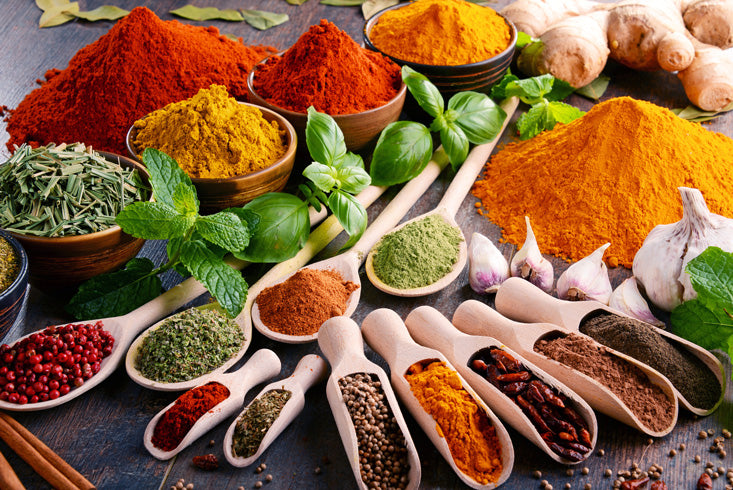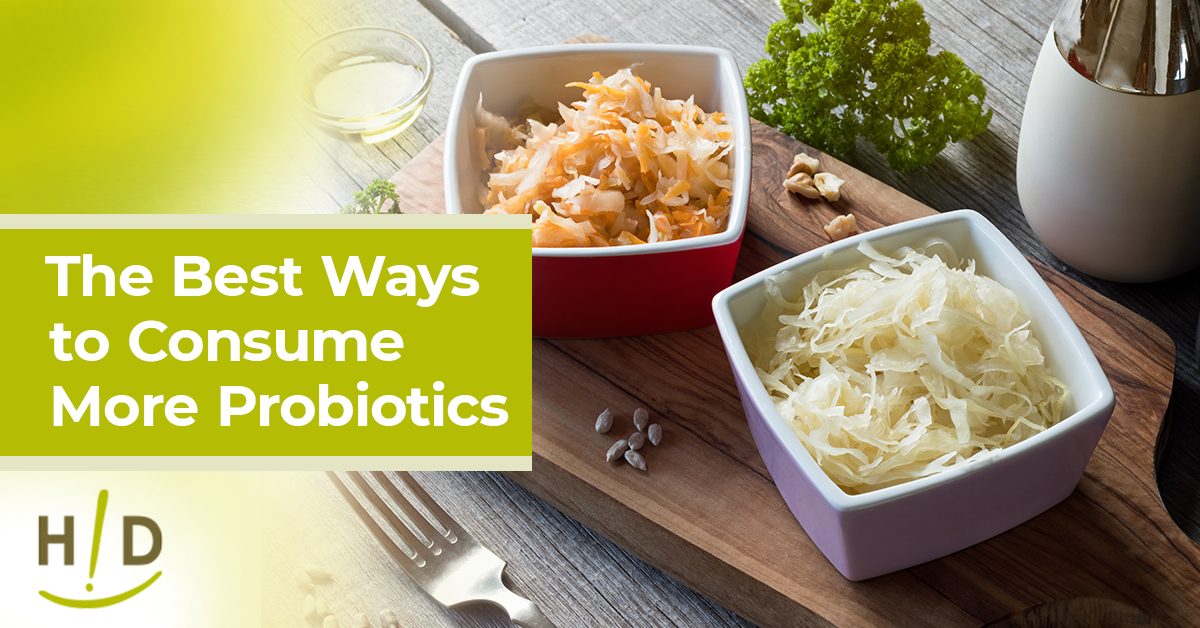By Susan Smith Jones, PhD
For thousands of years, humankind has relied entirely on plants, herbs, and spices to treat illnesses both minor and serious. On every continent, stretching back centuries, native cultures turned to indigenous plants to develop healing remedies. Over 4,500 years ago, Chinese and Native Americans began to organize bodies of knowledge about the medicinal properties of herbs and spices. In this article, I will feature some of my favorite culinary herbs and suggest ways to use them in food. While I have been a vegan for most of my adult life, I will suggest some common food uses for spices using animal products, as well as plant-based dishes, for those you who don’t embrace a vegan or vegetarian diet. As a culinary instructor and recipe developer for over 35 years (and a former natural-foods caterer and private chef for some entertainment celebrities), I always look for the freshest, best spices available, and also ones that are affordable and organic, if possible. Seek out fresh or dried culinary herbs and spices and fortify your health.
-
OREGANO — Who can imagine pizza without oregano? Before World War II, oregano was virtually nonexistent in the United States, but its import increased exponentially as American soldiers who had been stationed in Italy brought home a taste for pizza – and for this singular spice.
A native of northern Europe, oregano has been revered for its aromatic and medicinal properties since Greek and Roman times, when it was a symbol of joy and happiness.
Its volatile oils are potent inhibitors of harmful microbes, including the bacterium Staphylococcus aureus and the amoeba Giardia, making oregano valuable in warding off food-borne illness and encouraging healthy digestion. The spice is also a rich source of antioxidants, which protect against damage to cell structures in the body. It is also a nutrient-dense source of fiber, iron, and manganese. Aside from pizza, oregano pairs well with tomato-based dishes in Italian, Greek, South American, and Spanish cuisines.
-
PARSLEY LEAVES — In America, parsley is often relegated to a garnish, but its myriad health benefits suggest it should be front and center in your daily meals. Parsley’s feathery fronds were used as a medicine in ancient Greece long before they were consumed as a food.
Parsley has been used traditionally for over 2,000 years as a gentle herbal diuretic and to support healthy urinary tract and kidney function. From the 1850s through the early 1920s, parsley was listed in the United States Pharmacopoeia as an official diuretic. It is also a source of breath-freshening chlorophyll.
Given parsley’s store of antioxidants, including vitamins C and A, it’s no surprise that parsley has been shown to have cancer-fighting potential.
Parsley’s volatile oils can help protect against free-radical damage, neutralize environmental carcinogens, and inhibit tumor formation, particularly in the lungs.
Sprinkle parsley into salads, soups, Middle Eastern grain dishes, and rubs for chicken and seafood.
-
THYME — Throughout the years, thyme has indeed proved to be effective in supporting respiratory and digestive functions. Thyme’s benefit for respiratory problems including coughs, bronchitis, and chest congestion is two-fold: on the one hand, thyme has powerful antibacterial and antifungal properties that fight infection, and on the other, thyme has a relaxant effect on the irritated respiratory passageways.
Thymol, thyme’s primary volatile oil, has been shown to offer protection to cells in vital organs including the brain, kidney, and heart by significantly increasing the percentage of healthy fats in cell membranes.
Thyme’s antimicrobial power fights off pathogenic food-borne organisms such as Shigella, which can trigger diarrhea and damage intestines.
The spice is also an excellent source of the minerals iron and manganese.
Thyme makes for a delicate seasoning partner in French bouquet garni, omelets, bean dishes, and roast meat or poultry.
-
ROSEMARY – The piney, potent scent of rosemary has long been a herald of good health. In ancient Greece, it was a symbol of both memory and remembrance; Greek students wore rosemary wreaths on their heads during exams to improve their recall of facts, while mourners placed sprigs of rosemary on graves as commemoration.
Today we know that merely the scent of rosemary can, in fact, boost memory and cognitive performance. Rosmarinic acid, a component of rosemary leaves, can protect against the memory impairments of degenerative diseases such as Alzheimer’s.
Extracts of rosemary leaves have also demonstrated powerful effects against inflammation both in the respiratory system as a result of allergies and pollutants and in the joints as a result of arthritis and fibromyalgia. Further, rosemary appears to have anti-tumor potential.
Brewed as a tea, rosemary has been a traditional remedy for gaining strength after illness and soothing indigestion. Try sprinkling crushed Rosemary on a plate with some extra virgin olive oil. Makes a healthy and tasty alternative to butter for warm, crusty bread.
-
BASIL — For centuries, basil has been revered as a symbol of love and protection. It is thought to have originated in India, where it was placed in the hands of the dead to ensure safe passage to paradise. Pliny, the first century A.D. Roman scholar, deemed it an aphrodisiac, and in Italy, where a pot of basil left on a window sill was once a woman’s call to her lover, it has long been a signal of romance.
Today, we know that seasoning our food liberally with basil is an expression of love and protection for our bodies. Studies show that basil has potent anti-bacterial properties. Its volatile oils help defend against pathogens such as E. coli, Staphlococcus aureus and Listeria that can cause digestive distress and even death.
Its essential oils can even inhibit pathogenic bacteria including strains of Staphylococcus and Enterococcus that have become resistant to commonly used antibiotic drugs.
Eugenol, a component of basil’s volatile oils, has anti-inflammatory properties, working to block the COX enzyme in much the same way as over-the-counter anti-inflammatory drugs such as aspirin and ibuprofen. These anti-inflammatory properties offer promising benefits for rheumatoid arthritis or inflammatory bowel disease sufferers.
Basil also offers cardiovascular benefits. It is a source of vitamin A, which protects the cells that form the lining of the blood vessels and guards against the build-up of cholesterol in the arteries, a precursor to heart attack and stroke. The magnesium in basil helps improve blood flow and reduces the risk of heart arrhythmias and spasms.
Fresh basil is a culinary delight in warm months, but dried sweet basil is available year round. The concentration of volatile oils in the dehydrated leaves lends dried basil a more pungent bouquet than its fresh counterpart. Accordingly, it is an ideal addition to tomato-based pasta sauces, salads, stuffings, and vegetables such as squash and zucchini.
-
SESAME SEEDS — Sesame is truly an ancient spice, perhaps one of the oldest known to man. Its use is known to date back at least 4,000 years; in Egypt, a circa-2000 B.C. tomb drawing portrays a baker adding sesame seeds to dough. The culinary use of sesame seeds has stood the test of time not only for their distinctive taste that flavors many traditional Middle Eastern foods such as hummus and tahini, but also for their unique health benefits.
A good source of copper and manganese, sesame seeds contain a substance called sesamin, a special fiber that has a cholesterol-lowering effect. The seeds are also rich in phytosterols, substances known to lower cholesterol. Among nuts and seeds regularly eaten in the United States, sesame seeds have the highest phytosterol content.
Sesamin is being investigated for its potential to prevent high blood pressure, increase the body's supply of vitamin E, and protect the liver from oxidative damage.
Like that Egyptian baker, add sesame seeds to homemade breads and baked goods or sprinkle toasted sesame seeds into stir-fry recipes or salads for a healthy crunch.
-
SAGE – To be “sage” means to possess wisdom, and you would certainly be wise to incorporate this native Mediterranean spice into your diet. Research shows that sage can enhance memory and guard against the development of Alzheimer’s disease. In fact, Chinese sage contains compounds similar to those developed into modern drugs used to treat Alzheimer’s disease.
Like rosemary, sage is a source of rosmarinic acid, an antioxidant known to protect cells from free radical damage and to reduce inflammation, making sage beneficial for arthritis sufferers. Especially when brewed as a tea, sage has traditionally been used as a digestive aid, which quickly relieves gas and soothes an upset stomach. Its naturally occurring essential oils calm and relax muscle cramps and spasms.
Sage is a smart accompaniment to turkey and stuffing, bean dishes and baked squash. It adds warm, wonderful flavor to seafood, vegetables and breads. You may even burn sage leaves as incense to freshen the air.
-
JUNIPER BERRIES — The berries of the pine-scented juniper tree have been lauded as a source of health and merriment throughout the ages. They provide the unique flavor of gin and have been used as a substitute for both peppercorns and -- when roasted -- coffee. In folk medicine traditions since the ancient Greeks, juniper berries were employed as a remedy for various inflammatory and infectious diseases and as a digestive aid and diuretic.
Recent research reveals that the berries can indeed reduce inflammation and the pain associated with it. They also have demonstrated antimicrobial effects against bacteria, parasites, and fungi, which explains their benefit for warding off infection.
Preliminary evidence points to the berries' role in kidney health, as they may help detoxify the kidney of harmful substances. Juniper berries' natural essential oil content is credited with the herb’s support for urinary and bladder functions.
Adding a few of these tasty berries also brings a new layer of flavor to sauerkraut.
-
ONION — Though the pungent onion may bring tears to the eyes, when it comes to your health, these should be tears of joy. Since Egyptian times, when they were placed in the tombs of kings, onions have been bestowed with special significance for their ability to spice up bland meals and keep the body in optimal health.
The strong-tasting bulb has health benefits similar to its aromatic relative, garlic. It can help keep blood sugar levels in check, a boon for those with diabetes. A partner in cardiovascular health, studies show that onion can lower blood pressure and reduce risk factors for coronary heart disease including platelet aggregation and oxidation of cholesterol.
Onions also play a part in digestive health; their strong antibacterial properties ward off unfriendly microorganisms, while their store of the antioxidant quercetin and organosulfur compounds may lower the risk of colon cancer. The quercetin content may also account for onions' potential to lessen inflammation associated with such conditions as arthritis and asthma.
Add onions or onion powder to soups and stews in the cold and flu season. Sauté them to mellow the strong taste yet punch up everyday staples like vegetable dishes and hamburgers year-round.
-
CUMIN — Native to the Middle East, cumin has symbolized both love and greed in the course of history. The Romans associated it with avarice; Europeans in the Middle Ages carried it in their pockets at weddings as a symbol of fidelity and in Arabic traditions, a paste of ground cumin, pepper, and honey was thought to have aphrodisiac properties.
Today, cumin is coveted for its peppery taste and healing potential. It has traditionally been used to benefit the digestive system, relieving indigestion, gas, nausea, and lack of appetite. Research shows that the spice may stimulate the secretion of digestive enzymes necessary for proper nutrient assimilation.
Cumin itself is a very good source of iron, which plays a vital role in the production of hemoglobin and the transport of oxygen from the lungs to the body's cells.
Cumin seeds may also have anti-carcinogenic properties. In lab studies, cumin has prevented the development of cancerous tumors.
Cumin is a companion to Middle Eastern, North African, and Mexican cuisines. Add it to vegetable sautés, rice and bean dishes and barbecue spice blends.
-
FENNEL SEED — The licorice-tasting fennel seed has been ubiquitous in herbal medicine traditions, from the Ayurvedic, Chinese, Arabian, and Japanese Kampo healing systems to Hippocrates, the Greek “father of modern medicine.”
It has been used for generations to alleviate gas, bloating, upset stomach and heartburn. The United States once listed fennel as an official drug to be used for digestive problems.
Today, the spice is still used daily as an after-dinner digestive aid in countries such as Spain, Italy, and India, where you might be offered fennel seeds coated in pastel-colored candy as a post-meal treat.
Chewed or brewed as a tea, fennel seeds are known to stimulate the production of gastric juices and provide relief for the symptoms of irritable bowel syndrome. They also have anti-spasmodic properties, making them useful for gastrointestinal and menstrual cramps alike.
-
CELERY SEED — The seeds of the celery plant are proof positive that good things come in small packages. While the vegetable itself is chock full of health benefits, the dainty seeds contain a rich volatile oil with virtues all their own, extolled among the early Greeks and Romans as well as in Ayurvedic and Chinese medicines.
Among these healing traditions, celery seeds were widely used as a diuretic. Rich in minerals that regulate fluid balance, including potassium and sodium, celery seeds stimulate urine production, rid the body of excess fluid, and thereby promote urinary tract and kidney health. As they flush waste from the muscles and joints, celery seeds are also beneficial for arthritic conditions.
Celery seeds' potent flavor pairs well with tomato-based dishes, vegetable juices, soups and stews, and seafood and egg dishes. They are a good choice for those on a low-salt diet.
-
CILANTRO — In ancient China, the parsley-like cilantro plant (also known as coriander) was thought to grant immortality. Perhaps that's because the volatile oils found in its leaves have such strong life-giving properties.
Cilantro is a powerful antimicrobial. Research shows that a compound within cilantro, dodecenal, is twice as effective as commonly used antibiotic drugs in killing the deadly food-borne bacterium Salmonella.
In traditional herbal medicine, cilantro is thought to be beneficial for promoting urinary tract health and support healthy urinary function. In addition to its diuretic properties, cilantro is reported to support the respiratory system, and is used to loosen mucous congestion and to possibly relieve hay fever.
Cilantro is inseparable from Southwestern cuisines — what would salsa be without it? In the Middle East, it's used to flavor chutneys and curries, while Latin and Asian cooks employ it in soups and stews.
Make friends with your spice rack and, if possible, grow some culinary spices in pots in your kitchen and in your garden, weather permitting. Your body will thank you for doing this.
Susan Smith Jones, PhD: For more information on Susan, her work, and her latest faith-based books (Wired for High-Level Wellness, Invest in Yourself with Exercise, Kitchen Gardening, and Be the Change) please visit: www.SusanSmithJones.com. Sign up for Susan’s free, monthly Healthy Living Newsletters that are exclusive for subscribers and contain a wealth of holistic health and lifestyle info and delicious plant-based recipes.
References:
Oregano
Bouhdid, S., et al. Investigation of functional and morphological changes in Pseudomonas aeruginosa and Staphylococcus aureus cells induced by Origanum compactum essential oil. J Appl Microbiol. 2009 May;106(5):1558-68. Epub 2009 Feb 16.
Zheng W, Wang SY. Antioxidant activity and phenolic compounds in selected herbs. J Agric Food Chem 2002;49:5165-70 2002.
Parsley Leaves
Hirano R, Sasamoto W, Matsumoto A et al. Antioxidant ability of various flavonoids against DPPH radicals and LDL oxidation. J Nutr Sci Vitaminol (Tokyo). 2001 Oct;47(5):357-62 2001.
Zheng, GQ. Inhibition of benzopyrene-induced tumorigenesis by myristicin, a volatile aroma constituent of parsley leaf oil. Carcinogenesis. 1992 Oct;13(10):1921-3.
Thyme
Fabio A, et al. Screening of the antibacterial effects of a variety of essential oils on microorganisms responsible for respiratory infections. Phytother Res. 2007 Apr;21(4):374-7.
Begrow F, et al. Impact of Thymol in Thyme Extracts on Their Antispasmodic Action and Ciliary Clearance. Planta Med. 2009 Oct 6.
Youdim KA, Deans SG. Beneficial effects of thyme oil on age-related changes in the phospholipid C20 and C22 polyunsaturated fatty acid composition of various rat tissues. Biochim Biophys Acta 1999 Apr 19;1438(1):140-6 1999. PMID:12480.
Bagamboula CF, Uyttendaeleand M, Debevere J. Inhibitory effect of thyme and basil essential oils, carvacrol, thymol, estragol, linalool and p-cymene towards Shigella sonnei and S. flexneri. Food Microbio 2004 Feb;21 (1):33-42. 2004.
Basil
Elgayyar M, Draughon FA, Golden DA, Mount JR. Antimicrobial activity of essential oils from plants against selected pathogenic and saprophytic microorganisms. J Food Prot 2001 Jul;64(7):1019-24 2001. PMID:12650.
Rosemary
Alkam T, Nitta A, Mizoguchi H, Itoh A, Nabeshima T. A natural scavenger of peroxynitrites, rosmarinic acid, protects against impairment of memory induced by Abeta(25-35). Behav Brain Res. 2007 Jun 18;180(2):139-45. Epub 2007 Mar 12.
Inoue K, et al. Effects of volatile constituents of rosemary extract on lung inflammation induced by diesel exhaust particles. Basic Clin Pharmacol Toxicol. 2006 Jul;99(1):52-7.
Peng CH, et al. Supercritical fluid extracts of rosemary leaves exhibit potent anti-inflammation and anti-tumor effects. Biosci Biotechnol Biochem. 2007 Sep;71(9):2223-32. Epub 2007 Sep 7. and placebo-controlled trial. Phytother Res. 2005 Feb;19(2):148-51.
Sage
Houghton P. Sage, alternative treatment to Alzheimer’s drug. Research presented at the British Pharmaceutical Conference in Harrogate, September 15-17, 2003. 2003.
Kelm MA, Nair MG, Strasburg GM, DeWitt DL. Antioxidant and cyclooxygenase inhibitory phenolic compounds from Ocimum sanctum Linn. Phytomedicine 2000 Mar;7(1):7-13 2000. PMID:12240.
Prakash P, Gupta N. Therapeutic uses of Ocimum sanctum Linn (Tulsi) with a note on eugenol and its pharmacological actions: a short review. Indian Journal Physiol. Pharmacol 2005; 49: 125-131.
Sesame
Miyawaki T, Antihypertensive effects of sesamin in humans. J Nutr Sci Vitaminol (Tokyo). 2009 Feb;55(1):87-91.
Yamashita K, et al. Comparative effects of flaxseed and sesame seed on vitamin E and cholesterol levels in rats. Lipids. 2003 Dec;38(12):1249-55.
Juniper Berries
Akkol EK, Güvenç A, Yesilada E. A comparative study on the antinociceptive and anti-inflammatory activities of five Juniperus taxa. J Ethnopharmacol. 2009 Sep 7;125(2):330-6. Epub 2009 Jun 6.
Pepeljnjak S, et al. Antimicrobial activity of juniper berry essential oil (Juniperus communis L., Cupressaceae). Acta Pharm. 2005 Dec;55(4):417-22.
Butani L, et al. Amelioration of tacrolimus-induced nephrotoxicity in rats using juniper oil. Transplantation. 2003 Jul 27;76(2):306-11.
Onion
Kook S, Kim GH, Choi K. The antidiabetic effect of onion and garlic in experimental diabetic rats: meta-analysis. J Med Food. 2009 Jun;12(3):552-60.
Huxley RR, Neil HAW. The relation between dietary flavonol intake and coronary heart disease mortality: a meta-analysis of prospective cohort studies,. European Journal of Clinical Nutrition (2003) 57, 904-908. 2003.
Pierre S, Crosbie L, Duttaroy AK. Inhibitory effect of aqueous extracts of some herbs on human platelet aggregation in vitro. Platelets. 2005 Dec;16(8):469-73.
Bianchini F, Vainio H. Allium vegetables and organosulfur compounds: do they help prevent cancer? Environ Health Perspect. 2001 Sep;109(9):893-902.
Shaik YB, et al. Role of quercetin (a natural herbal compound) in allergy and inflammation. J Biol Regul Homeost Agents. 2006 Jul-Dec;20(3-4):47-52.
Cumin
Platel K, Srinivasan K. Influence of dietary spices or their active principles on digestive enzymes of small intestinal mucosa in rats. Int J Food Sci Nutr. 1996 Jan;47(1):55-9.
Padhye S, et al. From here to eternity - the secret of Pharaohs: Therapeutic potential of black cumin seeds and beyond. Cancer Ther. 2008;6(b):495-510.
Celery Seeds
Zhou, Y, et al. A novel compound from celery seed with a bactericidal effect against Helicobacter pylori. J Pharm Pharmacol. 2009 Aug;61(8):1067-77.
Zheng, GQ. Chemoprevention of benzopyrene-induced forestomach cancer in mice by natural phthalides from celery seed oil. Nutr Cancer. 1993;19(1):77-86.
Cilantro
Burt, Sara. Essential oils: their antibacterial properties and potential applications in foods—a review. International Journal of Food Microbiology Volume 94, Issue 3, 1 August 2004, Pages 223-253.








